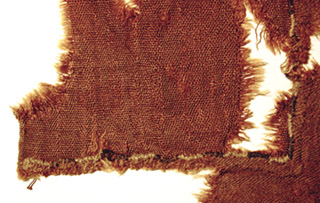

| History | Library | Legal Notice | Deutsch |
|
• Program • Hallstatt • Travel info • Overview map • Esslingen |
Hallstatt-Textiles
The Iron Age salt mines in Hallstatt (Salzwelten Hallstatt) provides the excellent conditions for the preservation of organic materials, a look into the world 3000 years ago, in this form in most archaeological sites is not possible. The textile remnants, due to their rarity are especially valuable. The textiles from the salt mines are mostly madeof wool and are sometimes extremely fine and of high quality. Iron Age fabrics were made on warp-weighted looms, and were not limited to tabby, the most basic weave. A variety of more complex weaving techniques are represented by the surviving Hallstatt textiles, producing sophisticated optical effects which are often multicoloured. The natural range of sheep's wool colours was extended by the use of blue, green and yellow dyes which were then used to produce striped and checkered fabrics. Hallstatt has also provided evidence for sewing and cloth-cutting techniques. The hems and seams were foci for virtuosic finishing, as attested by an impressive example of brown-and-white decorative stitching. By contrast there are also repairs which at times use very coarse thread and appear to have been done in a hurry. The surviving fragments from Hallstatt are all too small to reconstruct entire garments with certainty. |
|






